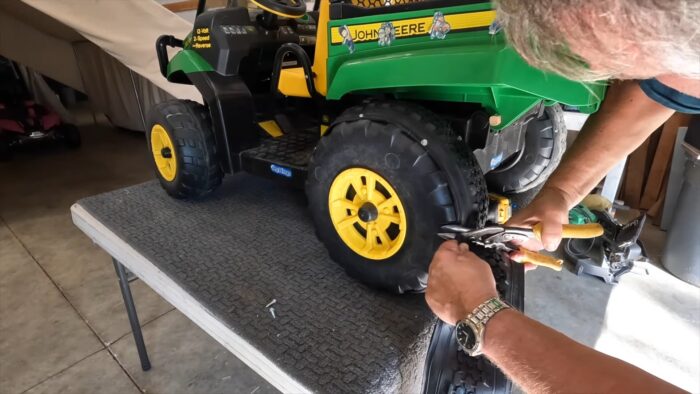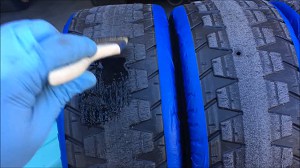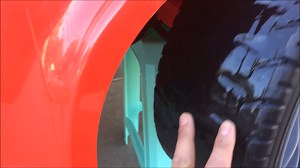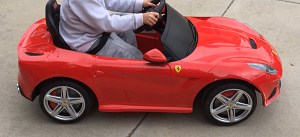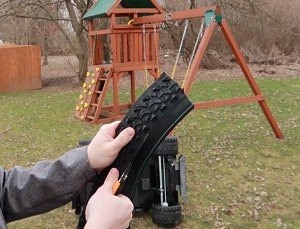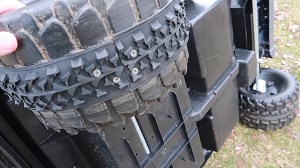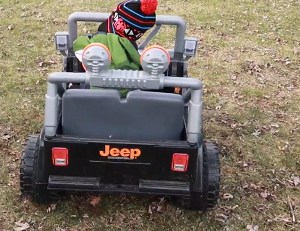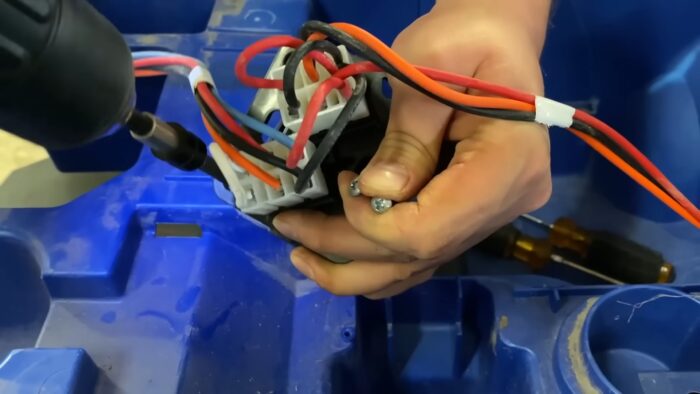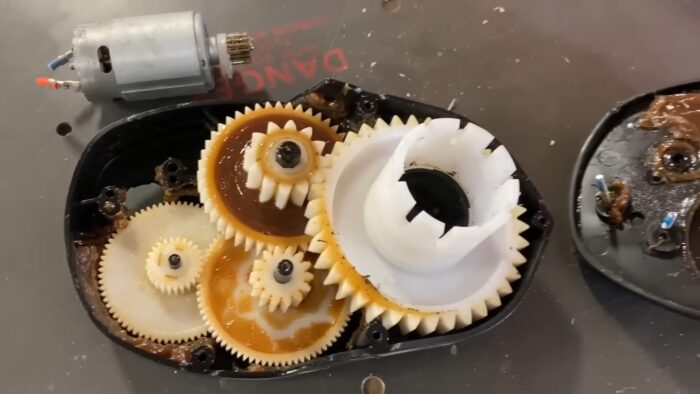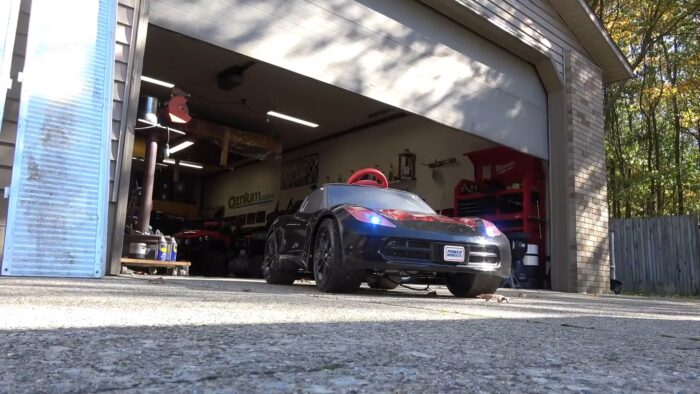Parents watch their toddlers drive around on their power wheel, going back and forth in the backyard. It goes on for months until the little ones have gone through every inch of grass in the yard. They want more adventure and take their ride-on vehicle off-road. However, the plastic tires of the toy vehicle are not capable of taking on rough terrains; there’s no traction.
When children first ride their power wheels, it is a fun and exciting experience. As they grow older and become more comfortable with it, they want to take it to the next level.
But the problem is the vehicle’s performance can only do so much with plastic tires. You don’t have to purchase a new ride-on car; you can add traction to toy plastic wheels with a bit of modification. There are two methods you can try, rubber coating and traction bands.
The ‘how to add traction to plastic power wheels’ search on the Internet led you here. Now, you can sigh in relief while we guide you in adding traction to your child’s power wheels.
Before we dive in, to ensure your little one’s ride-on adventure continues with smooth and reliable traction consider replacing old tires on your kid’s power wheels.
Table of Contents
Step by Step to Add Traction to Plastic Power Wheels
The power wheels mods tires use two standard methods that are effective in adding traction to plastic tires. Besides, these upgrades dampen tire noise, protect the plastic tires, and offer safer steering for the ride-on vehicle. Let’s get started.
Rubber Coating
There is a rubber coating for plastic wheels available in the market. It makes adding traction easy and tool-free. The coating products adhere effortlessly to plastic surfaces and are designed to offer the same qualities as rubber. Some of the best coating products you can purchase are Flex Seal Liquid and Flex Seal Spray.
What you’ll need:
- Several clean and small brushes
- Flex seal liquid
- Knife
Step 1: Remove the wheels
Overturn the vehicle or remove the tires. Cover the rims, wheels, and axles.
Step 2: Apply the liquid coat
Using the brush, apply the liquid coat. Reach between the grooves and the wheels.
Step 3: Let it dry
Let the first coat dry for at least eight hours before applying a second coat. Use a new brush for the second application. Check the tires after drying for another eight hours. With a scraping knife, remove any excess rubber.
Step 4: Test drive
Let your kid test drive the power wheel.
Note: The liquid rubber coating is messier than the spray, so make sure the working surface is covered and ready to catch any spills.
Traction Bands
The power wheels traction bands are an excellent substitute for buying new wheels. These bands are available in many sizes to accommodate various ride-on car models.
When purchasing these bands, make sure to choose the model suitable for your kid’s power wheels. An easier option than this is to create your own traction bands from old bicycle tires.
What you’ll need:
- Old bicycle tire
- Scissor
- Wood screws
- Drill
Step 1: Place the power wheel on the side
Turn the power to its side with the wheels facing up. Remove the battery and clean the tires.
Step 2: Cut the old bicycle tires
Measure the circumference of the tires, adding a little buffer. Cut the old tires into four equally long pieces.
Step 3: Drill the screws
Attach the cut tires in the middle and around the plastic tires. Drill the bicycle tires on the power wheel’s tires with screws.
Step 4: Trim excess
Align and trim any excess. Ensure a smooth transition between the two ends.
Step 5: Test drive
Let your kid drive the power wheel with its modified tires.
Tips: Make sure that the band is tight and fits snugly around the plastic tires.
How Traction Works and Why It Is Important
When you add traction to big wheel tires, it is easier for the power wheel to move forward, even on terrains it cannot previously take on. How does it work? What’s the explanation behind it?
Friction is the force that resists the relative motion between the two surfaces. Traction, on the other hand, is the friction between the road’s surface and the wheel. High friction is desirable, but you need enough traction to keep the car steadily running on the road.
When a vehicle’s tires lose grip, chances are it will start skidding on the road. Several things affect road grip, like the contact surface’s material, texture, the force pressing the surfaces together, and other materials between the contact surfaces. While the first three factors are constant, the others can change, and it is up to the driving style to adapt to these factors.
Traction is not something you can increase through electronic systems. It requires a physical addition to the tires, one with a higher value of friction. You can compare it to sanding an icy road or using snow chains. A rubber coating or traction band can help increase traction in a power wheel for a more permanent solution.
Other Power Wheel Upgrades
The power wheels dune racer rubber tires are one good example of a successful modification of a ride-on vehicle. Adding traction is not the only upgrade you can do to your child’s toy car. But before you go on a customization spree, determine whether the unit you have is easy to modify.
Generally, 12v power wheels are effortless to modify since they have electronics capable of receiving more power with little to no issues. But like every model, 12v and 24v both have their benefits and disadvantages. John Deere power wheels are one of the most popular types used for modification purposes.
Consider that while 12V power wheels are generally easier to modify due to their adaptable electronics, 24V models might offer enhanced speed and performance capabilities for those seeking a more thrilling ride modification experience. Now, let’s get on with the list.
Batteries
The standard battery of most power wheels is 12-volt. If you want the vehicle to go faster, you can upgrade it to 18-volt. For enthusiasts seeking additional modifications, some even explore power wheels drill conversion, a method where a cordless drill is ingeniously repurposed to enhance the power delivery.
Going a few volts higher is best, but going from 12-volt to 36-volt will put too much strain on the gears and motors.
Motors
Swapping out motors is the ideal upgrade for older kids who want more power and speed on their toy cars. A direct-drive electric motor is quite expensive but will seriously boost the performance of the power wheel.
If you want something less than this, opt for a ride-on vehicle designed for 4-year-olds. Depending on the motor you will swap it with, it will transform the power wheel into an off-road toy car.
If you encounter any motor problems, such as reduced efficiency or clicking sound, consider consulting online forums or reaching out to customer support for effective troubleshooting tips.
Gears
After swapping motors, you should not forget about the gears. You need to install stronger gears that can provide optimal performance to keep up with the speed and power of the motor and batteries.
When modifying a power wheel, remember the three primary parts: the battery, motor, and gear. Too powerful batteries and gears can cause motor-related problems; thus, these three must be on the same page.
Visual
Aside from the performance standpoint of modification, improving the appearance of the power wheel is another thing you can focus on. It is a fun project that kids can get involved in, customizing their toy car to look the same as real-life vehicles they see on the streets. The options for visual upgrades are limitless, from LED lights to sound effects.
These upgrades are easy if you are handy with electricity and wiring or similar repairs. But for those who feel that they are not experienced enough for these power wheel modifications, it would be best to let someone familiar with this kind of project handle the task. You don’t want to risk damaging the ride-on vehicle and end up having to buy a new one.
Final Thoughts
Your now older toddler can enjoy cruising around in a toy car with upgraded performance that can take on most terrains. With added traction of power wheels rubber tires, the vehicle can run faster and have better stability.
The power wheels rubber tire covers are an easy modification anyone can do with the help of our tutorial. If you are thinking of other power wheel upgrades, we’ve got that covered too.
We hope this article on how to add traction to plastic power wheels helps provide the solution you require for your kid’s power wheel. Do you know someone who might need these tips and step-by-step guides? Please share this with them. As for your experiences dealing with traction on power wheels, comment them below. We love to hear from you!


